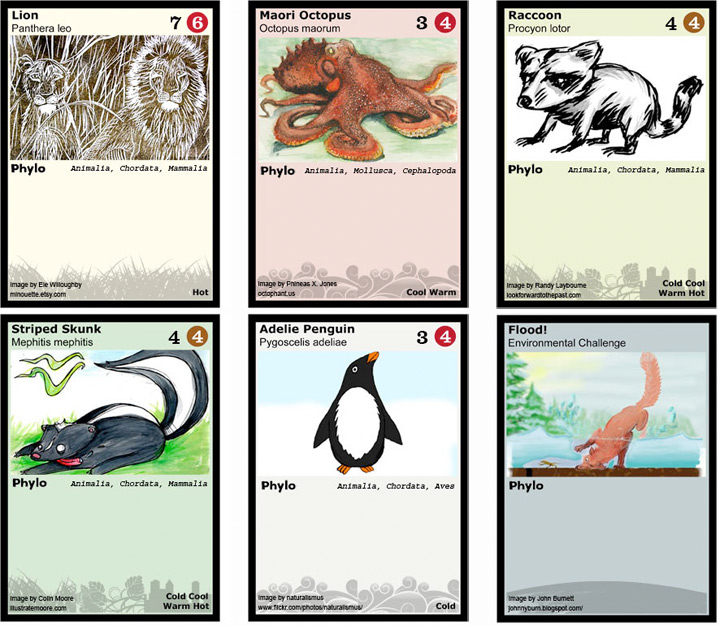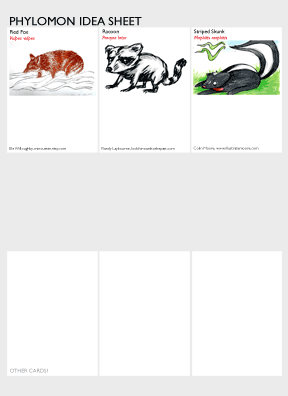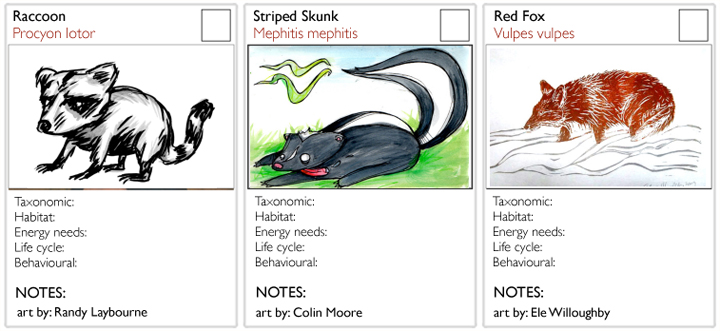
~ E. O. Wilson.
- What is the Phylo Project (although note that folks still refer to it affectionately as the "Phylomon Project")? Click here to read the introduction.
- Note: official URL is now - http://phylogame.org
- Forum for general discussion link
- Phylo image submissions - art | photos | school
- Join the Facebook Group
March 11/2010: NAME CHANGE - NOW CALLED "PHYLO":
Things are humming along! We have over 100 images submitted, 30 or so queued up for card production, and over 40 folks signed up on the forum (in fact, one set of rules is arguably close to beta testing). The response has been simply wonderful, and these numbers don't even the include the numerous comments and chats culled from coffee meetings to blog posts to tweets. To us, this outpouring is something else, especially in light of the fact that we've technically only seeded an "idea" out there!
The website, itself, is being prodded, poked and tweaked as we speak, and should be ready for a beta launch in about a week or two. At this point in time, the main emphasis on the website is that it allows set-up, production and printing of cards in a low maintenance and open access manner. The cards will initially have only a few major attributes on them, but will also allow for commentary so that we can continue to polish the way cards will look over time. Hopefully, you'll find it a treat when it's public, but if not, then do go with the crowd sourcing mentality of this project, and let us know what you think.
Probably the main news to report is that we've decided to change the name of the project to "PHYLO" (note that the logo above is only a "tester"). This was primarily due to conversations with various folks (notably Cory) who felt that having a name with "mon" at the end could set ourselves up for trademark issues since there is inferred linkage to the term "Pokemon". In any event, the "official" URL will now be http://phylogame.org (although note that the http://phylomon.org will still work).

Finally, with info on hand from the forum, we've quickly made some card mock-ups (see above) so that you can get the general sense and feel of the cards. We've done this because a number of media outlets have inquired about the project, and many of these requested visuals. Anyway, for now, note that the cards have a few attributes already. These include: (at the top), name, latin name, a number depicting scale, another number depicting food chain rank embedded in a coloured circle (indicative of diet); (in the middle) some basic classification data; and (at the bottom) simple habitat information, name and URL of artist, and some info regarding preferred climate. More detail about this can be found at the forum, but better yet, sign up and weigh in on the various discussions.
Cheers
Dave Ng
February 1/2010: CALL FOR GAME DESIGN IDEAS (edited from January 25/2010):
Please do check out the images that have been submitted so far - they are, in a word, awesome! Also, at this point in time, we have gathered a collection of individuals from the scientific community to participate in the project. They will be asked to focus on coming up with 12 potential attributes suitable for presentation on these cards (although use of all 12 may be subjected to space constraints). Note that their choice of 12 will be strongly influenced by the feedback culled from a variety of different communities, particularily those who are passionate about game design.
To facilitate this, we have started a forum at http://phylomon.forumotion.net/ Anyone can view the forum's content, but registration is required for participation. You can self register at this forum (by posting a new topic or leaving a comment). Hopefully it will soon be an independent place for dialogue and discussion on the project. We also have a FriendFeed site at http://friendfeed.com/phylomon. This site can provide a place to upload content (word docs, images, pdfs), should you not have a website/blog to present files. Reading the FriendFeed is open to anyone, but participation/uploading privileges will require a quick registration process. For gamers, we are interested in all of your ideas, including specific calls for organism images, or other specialized cards. In particular, it would be wonderful if there are folks out there who feel the urge to fully design gameplay rules. We hope that a number of these rules can facilitate initial beta testing of preliminary card sets and card games. Rules of this nature will eventually inhabit a "game" section of the finished official phylomon website. Again, please visit and register for the Phylomon forum by starting or contributing to a discussion (registration is initially prompted when you want to start a topic or comment in the thread).. |
 |
|||
|
You can take your notes on this sheet! (pdf)
|
||||
Again, if you have any questions, don't hesitate to email me or send a tweet. The official website is on track for an early March 2010 release. This website will be fully capable of generating imaged blank cards. We are hoping that the first of the working card sets with edited content and a variety of game play rules to be available by April/May.
Cheers
Dave Ng
January 11/2010: INITIAL SOFT LAUNCH:

Well 2010 is here, a.k.a. the International Year of Biodiversity, and to us at the SCQ, it means that we're finally ready to go ahead with our long awaited phylomon project. “What is this?” you ask? Well, it's an online initiative aimed at creating a Pokemon card type resource but with real creatures on display in full “character design” wonder. Not only that - but we plan to have the scientific community weigh in to determine the content on such cards (note that the cards above are only a mock-up of what that content might be), as well as folks who love gaming to try and design interesting ways to use the cards. Then to top it all off, members of the teacher community will participate to see whether these cards have educational merit. Best of all, the hope is that this will all occur in a non-commercial-open-access-open-source-because-basically-this-is-good-for-you-your-children-and-your-planet sort of way.
Why are we doing this?
Well, it was conservationist Andrew Balmford's letter (Why Conservationists Should Heed Pokemon, Science. 2002 Mar 29;295(5564):2367.), published in Science, that provided the proverbial kick in the pants. Essentially, he did this eye opening study to show that children as young as eight had the remarkable ability to identify and characterize upwards of 120 different Pokemon characters. However, when the same rubric was applied using photos of “real” flora and fauna (animals and plants that lived in the children's back yards) the results were simply horrendous.
“Our findings carry two messages for conservationists. First, young children clearly have tremendous capacity for learning about creatures (whether natural or man-made), being able to at age 8 to identify nearly 80% of a sample drawn from 150 synthetic “species.” Second, it appears that conservationists are doing less well than the creators of Pokemon at inspiring interest in their subjects: During their primary school years, children apparently learn far more about Pokemon than about their native wildlife and enter secondary school being able to name less than 50% of common wildlife types. Evidence from elsewhere links loss of knowledge about the natural world to growing isolation from it. People care about what they know. With the world's urban population rising by 160,000 people daily, conservationists need to reestablish children's links with nature if they are to win over the hearts and minds of the next generation.”
In effect, Andrew asked, “Can we do whatever Pokemon does so well, but with the reality of biodiversity and ecology providing the content?” With this brilliant seed of an idea, the folks behind the SCQ have been wondering whether the ideals of this thing called “WEB 2.0” can work towards Andrew's suggestion. And with his blessing, we are now ready to pursue his idea full heartedly, optimistic that the good old internet, its social networking ability, and its often wonderfully active and engaged citizens will deliver something amazing.
How will this happen?
Well, as we speak, a website is being carefully developed, but more importantly, it is being programmed using the nuts and bolts of the open source Wordpress software and the remarkable image organizing prowess of Flickr. The idea here is that whatever template is produced, it will be relatively low maintenance to use and to look after, and that there will be ample opportunity for others to use it in their own locales, and for it to be tweaked, improved, for further use. If you'd like to see the initial layout for this website, you can download this pdf which includes the general logistics and rough design schematics. At this point, we are planning to launch the website at phylomon.org sometime in late February, early March 2010.
But what can I do right now?
In a nut shell, our first order of business is to drum up enthusiasm from the graphic design and illustration community. We're actually hoping for something wonderful (and a bit viral) like the 700 Hoboes Project (another great web based art collaboration). In this respect, here are a few things you can do to help:
1. You can spread the word to as many folks as you can. In particular, any courting of the character design community to play would be brilliant, although any word of mouth is also greatly appreciated.
2. As images begin to come in, feel free to comment at the Flickr group site. It is this sort of feedback that will help guide our choices for images used in the actual cards. We're actually quite curious what type of imagery will be presented (will it be ultra realistic, more character design focused, something in between, or a bit of everything)
3. Better yet, if you are an artist, or just someone who is intrigued, then do submit a picture. If so, here are a couple of things to consider.
FIRST: whatever image you provide, the copyright will still remain with you, the artist. What you agree to, is allowing us the use of the image in a non-commercial educational format specifically for the home printing/production of phylomon cards.
SECOND: the image you supply would only need to be given at relatively small dimensions (150dpi at 2.4 inches x 1.5 inches or 360px X 225px). This is done on purpose so that the small size of the image limits its usefulness for the more unscrupulous folks out there. As well, attribution and linkage to the artist's personal website will be provided throughout the process. This way, if a viewer loves the artist's image, and, say, wants to buy it full size, or wants to inquire if it's available as a t-shirt, he/she will have the option to follow up on to the artist's personal URL.
THIRD: Submissions will occur via a Phylomon Flickr group (links provided below). Full submission details (i.e. specific size of images and tags to include) can be found at the Flickr group pages. As we plan to incorporate a variety of communities in this project, we will start by creating three Phylomon submissions groups. One for the graphic design/illustration community, one for the photography community, and also one for the school community (i.e. kids and students can play too!). We do plan on initially focusing on the illustration elements (where perhaps reality can be embedded during gameplay - i.e. the card can do extra when coupled with a photo brought in by the child), but go ahead, check them all out below and submit away!
Phylomon submissions (Graphic Design and Illustration Community)
Phylomon submissions (Photography Community)
Phylomon submissions (School Community)
FOURTH: It is hoped that a large repository of great images will collect over time. From these pools, specific images will be chosen for card production. This will involve our team contacting the artist for permission to include the image in the main Phylomon flickr account to create a “card queue” which in turn will be worked upon by a community of biodiversity scientists (graduate and undergraduate students, with some oversight from Faculty/Research Scientists) who will be assigned the task of providing scientifically literate content for each card. This content will also provide and inform logistics for gameplay design.
Anyway, if you have any questions about the project please do contact me via email or twitter. I would love to hear feedback and your ideas!
Cheers
Dave Ng
Michael Smith Laboratories, University of British Columbia
Vancouver, BC, Canada (11/01/2010)
Join the Phylomon Facebook Group
Big thank you to Randy Laybourne, Colin Moore, and Ele Willoughby for use of their awesome images; and, of course, to Andrew Balmford and his colleagues for the wonderful idea.